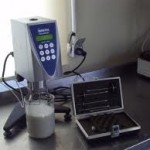International Test Standard-ASTM e466 Sodium Carboxymethylcellulose
1. Non-Newtonian fluid properties of Sodium Carboxymethylcellulose leads to different measured viscosity numbers under different conditions.
According to the difference of intrinsic friction shear stress and percentage speed variation, viscous fluids can be divided into Newtonian fluids and non-Newtonian fluids. A great number of data have shown that fluid characteristics gradually appear non-Newtonian fluids with the increase of Sodium Carboxymethylcellulose concentration. For polymer and high-viscosity Sodium Carboxymethylcellulose, it merely appears non-Newtonian fluid characteristics even at low concentration of glue solution.
Brookfield LVTD is the unified viscometer in product tests and in line with international test standards. In case we cannot unify test standards with the client, we hope the client can offer samples for testing so that it helps to better unify the standards.
2. Frequently Occurring Problems in Viscosity Measurement of Sodium Carboxymethylcellulose
Different measured data resulting from different rotor speeds during the measurement process by rotational viscometer are ofte
 n considered as inaccurate measurement or a problem with the viscometer, but in fact, this is because different rotor speeds have different shear stresses for the solution and the measured viscosity by rotational viscometer is the absolute viscosity of various Newtonian fluids and the apparent viscosity of non-Newtonian fluids.
n considered as inaccurate measurement or a problem with the viscometer, but in fact, this is because different rotor speeds have different shear stresses for the solution and the measured viscosity by rotational viscometer is the absolute viscosity of various Newtonian fluids and the apparent viscosity of non-Newtonian fluids.
Brookfield viscometer is the most classic and commonly used standard viscometer in the world. It is equipped with a variety of rotor speeds to measure the liquid viscosity within different measuring ranges. Different sizes of rotor can lead to difference of contact area with liquids, and different rotation speeds can also result in the difference of shear rate for fluids.
Consequently, different rotor speeds can be selected according to the viscosity of fluids. The smaller the rotor is, the slower the rotation speed will be and then the higher the measured viscosity value will be. Otherwise, the measured viscosity will be lower.
